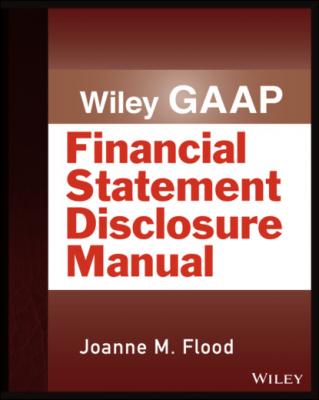Wiley GAAP: Financial Statement Disclosure Manual. Joanne M. Flood
Читать онлайн.| Название | Wiley GAAP: Financial Statement Disclosure Manual |
|---|---|
| Автор произведения | Joanne M. Flood |
| Жанр | Бухучет, налогообложение, аудит |
| Серия | |
| Издательство | Бухучет, налогообложение, аудит |
| Год выпуска | 0 |
| isbn | 9781119365723 |
4 ASC 215 STATEMENT OF SHAREHOLDER EQUITY
AUTHORITATIVE LITERATURE
ASC 215, Statement of Shareholder Equity, contains one Subtopic:
ASC 215‐10, Overall
That Subtopic merely provides a referral to disclosure guidance in ASC 505, Equity.
5 ASC 220 INCOME STATEMENT—REPORTING COMPREHENSIVE INCOME
1 Authoritative Literature Subtopics Scope
3 Disclosure and Presentation Requirements ASC 220‐10, Overall Format of Statement of Income and Comprehensive Income Entities with an Outstanding Noncontrolling Interest The Order of Presentation and Headings Consistency of Form Aggregation Income from Continuing Operations Income from Continuing Operations Net Income Items of Other Comprehensive Income ASC 220‐20, Unusual Items or Infrequently Occurring Items ASC 220‐30, Business Interruption Insurance
4 Disclosure and Presentation Examples Example 5.1: Basic Order of Income Statement and Comprehensive Income Statement Example 5.2: A Multiple‐Step Format for Income from Continuing Operations Example 5.3: A Single‐Step Format for Income from Continuing Operations Example 5.4: Combined Statement of Income and Comprehensive Income with “Net of Tax” Presentation Example 5.5: Combined Statement of Income and Comprehensive Income with “Gross of Tax” Presentation Example 5.6: Two Separate but Consecutive Statements of Income and Comprehensive Income—Net of Tax Presentation Example 5.7: Note X: Income Taxes Example 5.8: Unusual or Infrequently Occurring Item—Fire at Manufacturing Facility Example 5.9: Unusual or Infrequently Occurring Items—Legal Settlement Example 5.10: Business Interruption and Insurance Recovery Example 5.11: Business Interruption and Insurance Recovery
AUTHORITATIVE LITERATURE
In financial reporting, performance is primarily measured by net income and its components, which are presented in the income statement. A second performance measure—comprehensive income—is a more inclusive notion of performance than net income. It includes all recognized changes in equity that occur during a period except those resulting from investments by owners and distributions to owners.
Because comprehensive income includes the effects on an entity of economic events largely outside of management's control, some have said that net income is a measure of management's performance and comprehensive income is a measure of entity performance.
In contrast to the statement of financial position, which provides information about an entity at a point in time, an income statement provides information about a period of time. It reflects information about the transactions and other events occurring within the period. Most of the weaknesses of an income statement are a result of its periodic nature. Entities are continually creating and selling goods and services, and at any single point in time some of those processes will be incomplete.
Subtopics
ASC 220, Income Statement—Reporting Comprehensive Income, contains three Subtopics:
ASC 220‐10, Overall
ASC 220‐20, Unusual Items or Infrequently Occurring Items
ASC 220‐30, Business Interruption Insurance
The three Subtopics provide discrete information and are not interrelated. (ASC 220‐10‐05‐1 through 05‐5)
Scope
ASC 220 applies to all entities except it does not apply to the following:
Those that do not have any items of comprehensive income.
Those not‐for‐profit entities that are required to follow the guidance in ASC 958‐205. (ASC 220‐10‐15‐3)
It applies to general purpose financial statements that present results of operations according to GAAP. (ASC 220‐10‐15‐5)
ASC 220 focuses on presentation and disclosure and does not address recognition and measurement requirements.
PRACTICE ALERT
Income statement classification is a frequent topic of SEC comment letters. While SEC rules only apply to public entities, preparers of financial statements can benefit from the findings of SEC reviewers. Topics for comment include:
Omitting certain required line items.
Disclosure of policies related to alternative permissible classifications under the guidance in ASC 235‐10.
Disaggregation of material amounts, especially in the “other expense” line item.
Separation of product and service revenue if greater than 10%. See the section on aggregation later in this chapter for more information.
Types of expenses in cost of sales. For example, do the amounts include depreciation and amortization?
If the entity includes a subtotal for operating income, determine if items are properly included in the operating and nonoperating categories.
